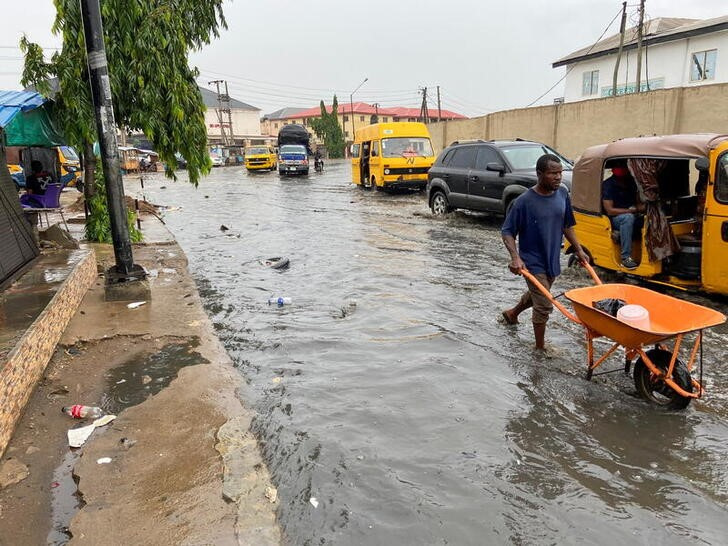By John Umeh
As Nigeria braces for another intense rainy season, the Federal Government has sounded a stark warning: 30 states and the Federal Capital Territory are at risk of severe flooding between April and November 2025. In response, state governments are scrambling to implement mitigation measures to protect over 1,249 flood-prone communities across 176 local government areas.
The alert came on Thursday from the Minister of Water Resources and Sanitation, Prof. Joseph Utsev, during the official release of the 2025 Annual Flood Outlook (AFO) by the Nigeria Hydrological Services Agency (NIHSA) in Abuja.
Utsev named Abia, Adamawa, Akwa Ibom, Anambra, Bauchi, Bayelsa, Benue, Borno, Cross River, Delta, Ebonyi, Edo, Gombe, Imo, Jigawa, Kebbi, Kogi, Kwara, Lagos, Nasarawa, Niger, Ogun, Ondo, Osun, Oyo, Rivers, Sokoto, Taraba, Yobe, Zamfara, and the FCT as high-risk flood zones.
He expressed concern over the worsening flood situation across the country, blaming climate change for its increasing frequency and intensity.
“This year’s outlook indicates that 1,249 communities in 176 LGAs across 30 states and the FCT are in high flood-risk zones,” Utsev stated. “Additionally, 2,187 communities in 293 LGAs across all 36 states and the FCT are categorized under moderate risk.”
The minister noted that coastal and riverine states—such as Bayelsa, Delta, Cross River, Lagos, Ogun, Rivers, and Ondo—would likely be hardest hit due to rising sea levels and tidal surges, potentially disrupting fisheries, wildlife habitats, and river transport.
Despite the dire forecast, Utsev stressed that with adequate preparation—including infrastructure upgrades, dredging, relocation, and community sensitization—flood disasters can be mitigated.
Permanent Secretary of the Ministry, Richard Pheelangwah, emphasized the human cost of floods, urging early action from all stakeholders.
NIHSA’s Director General, Umar Mohammed, announced a shift in approach with this year’s AFO, which now pinpoints specific vulnerable communities rather than just LGAs. The update, he said, will better support local response efforts and resilience building across key sectors including health, education, agriculture, and infrastructure.
States Mobilize Against Flood Threat
Across the federation, state governments are already taking steps in line with the federal advisory.
Anambra
The Anambra State Emergency Management Agency (ASEMA) confirmed alerts had been issued to 10 high-risk LGAs. Deputy Publicity Secretary Uche Okalawan said drainages were being cleared and structures obstructing waterways removed. Internally displaced persons (IDP) camps are also ready to receive evacuees.
Kwara
Commissioner for Environment Hajia Nafisat Buge said efforts are underway to expand the Asa River course in Ilorin and other flood-prone LGAs. Residents in low-lying areas have been advised to relocate, while new levees and dykes are under construction.
Ogun
The state’s Environment Commissioner, Ola Oresanya, revealed that the government is working with local councils to enforce flood alerts. Key interventions include dredging sections of the Ogun River, opening tributaries, and coordinating with the Ogun-Osun River Basin Authority to manage dam water releases.
Gombe
Spokesperson Amos Fabulous said the state’s proactive de-silting strategy, including contracted works with private firms, helped prevent floods last year. The state continues drainage maintenance and community sensitization.
Delta
Commissioner for Environment, Jamani Ejiro, said the state began sensitization and clearing of water channels before the federal alert was issued. “We’re on top of the situation,” he assured.
Nasarawa
The State Emergency Management Agency (NASEMA) has begun community awareness campaigns and the setup of IDP centers. Director Danladi Obagu urged residents in riverine areas to relocate, confirming that relief materials are being prepared.
Borno
Acting Director General of the State Emergency Management Agency, Ali Abdullahi, confirmed plans are underway to prevent a repeat of past flood disasters, with emphasis on early warning dissemination and the reinforcement of infrastructure in vulnerable communities.
As the 2025 rainy season approaches, the Federal Government has urged all stakeholders—from federal to local levels—to prioritize preparedness and take urgent actions to prevent a humanitarian and environmental crisis. The challenge now lies in translating early warnings into effective, community-level action across Nigeria.




